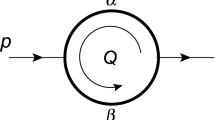Abstract
Using previously proposed techniques, we derive the defining system for a differential algebra associated with zero-divergence constraints. We study this system and present a simple class of its solutions.
Similar content being viewed by others
References
P. J. Olver, Applications of Lie groups to differential equations (Grad. Texts Math., Vol. 107), Springer, New York (1986).
V. V. Zharinov, “Lie-Poisson structures over differential algebras,” Theor. Math. Phys., 192, 1337–1349 (2017).
V. V. Zharinov, “Hamiltonian operators in differential algebras,” Theor. Math. Phys., 193, 1725–1736 (2017).
V. V. Zharinov, “Evolution systems with constraints in the form of zero-divergence conditions,” Theor. Math. Phys., 163, 401–413 (2010).
V. V. Kozlov, “Linear Hamiltonian systems: Quadratic integrals, singular subspaces, and stability,” Regul. Chaotic Dyn., 23, 26–46 (2018).
V. V. Kozlov and O. G. Smolyanov, “Hamiltonian approach to secondary quantization,” Dokl. Math., 98, 571–574 (2018).
A. A. Slavnov, “60 years of nonabelian gauge fields,” in: Particle Physics at the Year of Light (Proc. Seventeenth Lomonosov Conference on Elementary Particle Physics, Moscow, Russia, 20–26 August 2015, A. I. Studenikin, ed.), World Scientific, Singapore (2017), pp. 435–442.
A. A. Slavnov, “A possibility to describe models of massive non-Abelian gauge fields in the framework of a renormalizable theory,” Theor. Math. Phys., 193, 1826–1833 (2017).
A. A. Slavnov, “Quantization of non-Abelian gauge fields,” Proc. Steklov Inst. Math., 289, 286–290 (2015).
R. Ch. Kulaev, A. K. Pogrebkov, and A. B. Shabat, “Darboux system: Liouville reduction and an explicit solution,” Proc. Steklov Inst. Math., 302, 250–269 (2018).
I. Ya. Aref’eva and I. V. Volovich, “Notes on the SYK model in real time,” Theor. Math. Phys., 197, 1650–1662 (2018).
I. Aref’eva, M. Khramtsov, M. Tikhanovskaya, and I. Volovich, “On replica-nondiagonal large N saddles in the SYK model,” EPJ Web Conf., 191, 06007 (2018).
M. O. Katanaev, “Chern-Simons action and disclinations,” Proc. Steklov Inst. Math., 301, 114–133 (2018).
A. G. Sergeev, “String theory and quasiconformal maps,” Lobachevskii J. Math., 38, 352–363 (2017).
Author information
Authors and Affiliations
Corresponding author
Additional information
Prepared from an English manuscript submitted by the author; for the Russian version, see Teoreticheskaya i Matematicheskaya Fizika, Vol. 200, No. 1, pp. 3–18, July, 2019.
Rights and permissions
About this article
Cite this article
Zharinov, V.V. Hamiltonian Operators with Zero-Divergence Constraints. Theor Math Phys 200, 923–937 (2019). https://doi.org/10.1134/S0040577919070018
Received:
Revised:
Accepted:
Published:
Issue Date:
DOI: https://doi.org/10.1134/S0040577919070018




